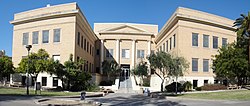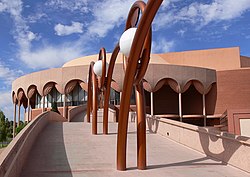
 Arizona State University's Division I athletic teams are called the Sun Devils, which is also the nickname used to refer to students and alumni of the university. They compete in the Pac-12 Conference in 20 varsity sports. Historically, the university has highly performed in men's, women's, and mixed archery; men's, women's, and mixedbadminton; women's golf; women's swimming and diving; baseball; and football. Arizona State University's NCAA Division I-A program competes in 9 varsity sports for men and 11 for women. ASU's current athletic director is Steve Patterson, who was appointed to the position in 2012 after Lisa Love, the former Senior Associate Athletic Director at the University of Southern California, was relieved of her duties.[148] Love was responsible for the hiring of coachesHerb Sendek, the men's basketball coach, and Dennis Erickson, the men's football coach.[149] Erickson was fired in 2011 and replaced by Todd Graham.[150]
Arizona State University's Division I athletic teams are called the Sun Devils, which is also the nickname used to refer to students and alumni of the university. They compete in the Pac-12 Conference in 20 varsity sports. Historically, the university has highly performed in men's, women's, and mixed archery; men's, women's, and mixedbadminton; women's golf; women's swimming and diving; baseball; and football. Arizona State University's NCAA Division I-A program competes in 9 varsity sports for men and 11 for women. ASU's current athletic director is Steve Patterson, who was appointed to the position in 2012 after Lisa Love, the former Senior Associate Athletic Director at the University of Southern California, was relieved of her duties.[148] Love was responsible for the hiring of coachesHerb Sendek, the men's basketball coach, and Dennis Erickson, the men's football coach.[149] Erickson was fired in 2011 and replaced by Todd Graham.[150]
ASU has won 23 national collegiate team championships in the following sports: baseball (5), men's golf (2), women's golf (7), men's gymnastics (1), softball (2), men's indoor track (1), women's indoor track (2), men's outdoor track (1), women's outdoor track (1), and wrestling (1).[151]
 In September 2009 criticism over the seven-figure salaries earned by various coaches at Arizona's public universities (including ASU) prompted the Arizona Board of Regents to re-evaluate the salary and benefit policy for athletic staff.[152] With the 2011 expansion of the Pacific-12 Conference, a new $3 billion contract for revenue sharing among all the schools in the conference was established.[153] With the infusion of funds, the salary issue and various athletic department budgeting issues at ASU were addressed. The Pac-12's new media contract with ESPN allowed ASU to hire a new coach in 2012. A new salary and bonus package (maximum bonus of $2.05 million) was instituted and is one of the most lucrative in the conference.[154] ASU also plans to expand its athletic facilities with a public-private investmentstrategy to create an amateur sports district that can accommodate the Pan American Games and operate as an Olympic Training Center.[155] The athletic district will include a $300 million renovation of Sun Devil Stadium that will include new football facilities.[156] The press box and football offices in Sun Devil Stadium were remodeled in 2012.[157]
In September 2009 criticism over the seven-figure salaries earned by various coaches at Arizona's public universities (including ASU) prompted the Arizona Board of Regents to re-evaluate the salary and benefit policy for athletic staff.[152] With the 2011 expansion of the Pacific-12 Conference, a new $3 billion contract for revenue sharing among all the schools in the conference was established.[153] With the infusion of funds, the salary issue and various athletic department budgeting issues at ASU were addressed. The Pac-12's new media contract with ESPN allowed ASU to hire a new coach in 2012. A new salary and bonus package (maximum bonus of $2.05 million) was instituted and is one of the most lucrative in the conference.[154] ASU also plans to expand its athletic facilities with a public-private investmentstrategy to create an amateur sports district that can accommodate the Pan American Games and operate as an Olympic Training Center.[155] The athletic district will include a $300 million renovation of Sun Devil Stadium that will include new football facilities.[156] The press box and football offices in Sun Devil Stadium were remodeled in 2012.[157] Arizona State Sun Devils football was founded in 1897 under coach Fred Irish.[158] Currently, the team has played in the 2012 Fight Hunger Bowl, the 2011 Las Vegas bowl, and the 2007 Holiday Bowl. The Sun Devils played in the 1997 Rose Bowl and won the Rose Bowl in 1987. The team has appeared in the Fiesta Bowl in 1983, 1977, 1975, 1973, 1972, and 1971 winning 5 of 6. In 1970 and 1975 they were champions of the NCAA Division I FBS National Football Championship. The Sun Devils were Pac-12 Champions in 1986, 1996, and 2007. Altogether, the football team has 17 Conference Championships and has participated in a total of 26 bowl games as of 2012.
Arizona State Sun Devils football was founded in 1897 under coach Fred Irish.[158] Currently, the team has played in the 2012 Fight Hunger Bowl, the 2011 Las Vegas bowl, and the 2007 Holiday Bowl. The Sun Devils played in the 1997 Rose Bowl and won the Rose Bowl in 1987. The team has appeared in the Fiesta Bowl in 1983, 1977, 1975, 1973, 1972, and 1971 winning 5 of 6. In 1970 and 1975 they were champions of the NCAA Division I FBS National Football Championship. The Sun Devils were Pac-12 Champions in 1986, 1996, and 2007. Altogether, the football team has 17 Conference Championships and has participated in a total of 26 bowl games as of 2012.
The university also participates in the American Collegiate Hockey Association (ACHA) and is billed as the top program within that league.[159] Beginning in 2013, ASU will be a founding member of the newWestern Collegiate Hockey League (WCHL). ASU Sun Devils Hockey will compete with NCAA Division 1 schools for the first time in 2012, largely due to the success of the program













.jpg)
.jpg)




